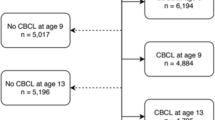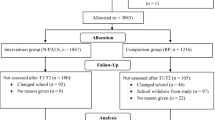Abstract
Although the positive youth development (PYD) model initially assumed inverse links between indicators of PYD and of risk/problem behaviors, empirical work in adolescence has suggested that more complex associations exist between trajectories of the two domains of functioning. To clarify the PYD model, this study assessed intraindividual change in positive and problematic indicators across Grades 5–10, and the links between these trajectories of development, among 2,516 participants from the 4-H Study of PYD (58.1% females; 64.9% European American, 7.0% African American, 12.3% Latino/a American, 2.6% Asian American or Pacific Islander, 1.8% Native American, 3.0% multiethnic-racial, and 8.4% with inconsistent race/ethnicity across waves). Results from person-centered analyses indicated that most youth clustered in the high trajectories of positive indicators and in the low trajectories of the negative ones. Consistent with past research, overlap between trajectories of positive and negative behaviors was found. These results suggest that theory and application need to accommodate to variation in the links between positive and problematic developmental trajectories.




Similar content being viewed by others
References
Baumrind, D. (1987). A developmetal perspective on adolescent risk taking in contemporary America. New Directions for Child Development, 37, 93–125.
Benson, P. L., Leffert, N., Scales, P. C., & Blyth, D. A. (1998). Beyond the “village” rhetoric: Creating healthy communities for children and adolescents. Applied Developmental Science, 2(3), 138–159.
Benson, P., Mannes, M., Pittman, K., & Ferber, T. (2004). Youth development, developmental assets and public policy. In R. M. Lerner & L. Steinberg (Eds.), Handbook of adolescent psychology (2nd ed., pp. 781–814). New York: Wiley.
Benson, P., & Pittman, K. (2001). Trends in youth development: Visions, realities, and challenges. Norwell (MA): Kluwer Academic Publishers.
Bergman, L. R., & Magnusson, D. (1997). A person-oriented approach in research on developmental psychopathology. Development and Psychopathology, 9, 291–319.
Bongers, I. L., Koot, H. M., van der Ende, J., & Verhulst, F. C. (2004). Developmental trajectories of externalizing behaviors in childhood and adolescence. Child Development, 75(5), 1523–1537.
Bongers, I. L., Koot, H. M., van der Ende, J., & Verhulst, F. C. (2008). Predicting young adult social functioning from developmental trajectories of externalizing behavior. Psychological Medicine, 38, 989–999.
Burt, K., Obradović, J., Long, J., & Masten, A. (2008). The interplay of social competence and psychopathology over 20 years: Testing transactional and cascade models. Child Development, 79(2), 359–374.
Damon, W. (2004). What is positive youth development? The Annals of the American Academy of Political and Social Science, 591, 13–24.
Dekker, M. C., Ferdinand, R. F., van Lang, N. D. J., Bongers, I. L., van der Ende, J., & Verhulst, F. C. (2007). Developmental trajectories of depressive symptoms from early childhood to late adolescence: Sex differences and adult outcome. Journal of Child Psychology and Psychiatry, 48(7), 657–666.
Dworkin, J. (2005). Risk taking as developmentally appropriate experimentation for college students. Journal of Adolescent Research, 20(2), 219–241.
Eccles, J., & Gootman, J. A. (Eds.). (2002). Community programs to promote youth development. Washington, DC: National Academies Press.
Gestsdóttir, S., & Lerner, R. M. (2007). Intentional self-regulation and positive youth development in early adolescence: Findings from the 4-H Study of Positive Youth Development. Developmental Psychology, 43(2), 508–521.
Gestsdóttir, S., Lewin-Bizan, S., von Eye, A., Lerner, J. V., & Lerner, R. M. (2009). The structure and function of selection, optimization, and compensation in middle adolescence: Theoretical and applied implications. Journal of Applied Developmental Psychology, 30, 585–600.
Hall, G. S. (1904). Adolescence: Its psychology and its relation to physiology, anthropology, sociology, sex, crime, religion, and education (Vol. I & II). Englewood Cliffs, NJ: Prentice-Hall.
Hamilton, S. F., & Hamilton, M. A. (1999). Building strong school-to-work systems: Illustrations of key components. Washington, D.C.: National School-to-Work Office.
Jeličić, H., Bobek, D., Phelps, E. D., Lerner, J. V., & Lerner, R. M. (2007). Using positive youth development to predict contribution and risk behaviors in early adolescence: Findings from the first two waves of the 4-H Study of Positive Youth Development. International Journal of Behavioral Development, 31(3), 263–273.
Johnston, L. D., O’Malley, P. M., Bachman, J. G., & Schulenburg, J. E. (2007). Monitoring the Future national results on adolescent drug use: Overview of key findings, 2006 (NIH Publication No. 07–6202). Bethesda, MD: National Institute on Drug Abuse.
Jones, B. L., Nagin, D. S., & Roeder, K. A. (2001). SAS procedure based on mixture models for estimating developmental trajectories. Sociological Methods and Research, 21, 374–393.
Larson, R. (2000). Towards a psychology of positive youth development. American Psychologist, 55, 170–183.
Lerner, R. M. (2005). Promoting positive youth development: theoretical and empirical bases. Paper presented at the workshop on the Science of Adolescent Health and Development. National Research Council/Institute of Medicine, Washington, DC, 8 Sept 2005.
Lerner, R. M. (2007). The good teen: Rescuing adolescents from the myths of the storm and stress years. New York, NY: The Crown Publishing Group.
Lerner, R. M. (2009). The positive youth development perspective: Theoretical and empirical bases of a strength-based approach to adolescent development. In C. R. Snyder & S. J. Lopez (Eds.), Handbook of positive psychology (2nd ed.). Oxford, England: Oxford University Press.
Lerner, R. M., Lerner, J. V., Almerigi, J., Theokas, C., et al. (2005). Positive youth development, participation in community youth development programs, and community contributions of fifth grade adolescents: Findings from the first wave of the 4-H Study of Positive Youth Development. Journal of Early Adolescence, 25(1), 17–71.
Lerner, J. V., Phelps, E., Forman, Y., & Bowers, E. P. (2009). Positive youth development. In R. M. Lerner & L. Steinberg (Eds.), Handbook of adolescent psychology (3rd ed., pp. 524–558). Hoboken, NJ: Wiley.
Lewin-Bizan, S., Bowers, E., & Lerner, R. M. (in press). One good thing leads to another: Cascades of positive youth development among American adolescents. Development and Psychopathology.
Maggs, J., Almeida, D., & Galambos, N. (1995). Risky business: The paradoxical meaning of problem behavior for young adolescents. The Journal of Early Adolescence, 15(3), 344–362.
Masten, A., Roisman, G., Long, J., Burt, K., Obradović, J., Riley, J., et al. (2005). Developmental cascades: Linking academic achievement and externalizing and internalizing symptoms over 20 years. Developmental Psychology, 41(5), 733–746.
Measelle, J., Stice, E., & Hogansen, J. (2006). Developmental trajectories of co-occurring depressive, eating, antisocial, and substance abuse problem in female adolescents. Journal of Abnormal Psychology, 115(3), 524–538.
Nagin, D. (2005). Group-based modeling of development. Cambridge MA: Harvard.
Nagin, D., & Tremblay, R. E. (1999). Trajectories of boys’ physical aggression, opposition, and hyperactivity on the path to physically violent and nonviolent juvenile delinquency. Child Development, 70(5), 1181–1196.
Nagin, D., & Tremblay, R. E. (2001). Analyzing developmental trajectories of distinct but related behaviors: A group-based method. Psychological Methods, 6(1), 18–34.
NCCP (2009a). National Center for Children in Poverty: Adolescent violence and unintentional injury in the United States. http://www.nccp.org.
NCCP (2009b). National Center for Children in Poverty: Adolescent mental health in the United States. http://www.nccp.org.
Odgers, C. L., Moffitt, T. E., Broadbent, J. M., Dickson, N., Hancox, R., Harrington, H., et al. (2008). Female and male antisocial trajectories: From childhood origins to adult outcomes. Development and Psychopathology, 20, 673–716.
Park, N., Lee, B., Bolland, J. M., Vazsonyi, A., & Sun, F. (2008). Early adolescent pathways of antisocial behaviors in poor, inner-city neighborhoods. Journal of Early Adolescence, 28(2), 185–205.
Pepler, D., Jiang, D., Craig, W., & Connolly, J. (2008). Developmental trajectories of bullying and associated factors. Child Development, 79(2), 325–338.
Phelps, E., Balsano, A., Fay, K., Peltz, J., Zimmerman, S., Lerner, R. M., et al. (2007). Nuances in early adolescent developmental trajectories of positive and problematic/risk behaviors: Findings from the 4-H Study of Positive Youth Development. Child and Adolescent Psychiatric Clinics of North America, 16, 473–496.
Phelps, E., Zimmerman, S., Warren, A. E. A., Jeličić, H., von Eye, A., & Lerner, R. M. (2009). The structure and developmental course of Positive Youth Development (PYD) in early adolescence: Implications for theory and practice.
Pittman, K., Irby, M., & Ferber, T. (2001). Unfinished business: further reflections on a decade of promoting youth development. In P. Benson & K. Pittman (Eds.), Trends in youth development: Visions, realities and challenges (pp. 4–50). Norwell, MA: Kluwer Academic Publishers.
Radloff, L. S. (1977). The CES-D scale: A self-report depression scale for research in the general population. Applied Psychological Measurement, 1(3), 385–401.
Roth, J. L., & Brooks-Gunn, J. (2003). What exactly is a youth development program? Answers from research and practice. Applied Developmental Science, 7, 94–111.
Small, S., & Rodgers, K. (1995). Teen assessment project. Madison, WI: School of Family Resources and Consumer Sciences, University of Wisconsin.
van Lier, P., Vitaro, F., Barker, E., Koot, H., & Tremblay, R. (2009). Developmental links between trajectories of physical violence, vandalism, theft, and alcohol-drug use from childhood to adolescence. Journal of Abnormal Child Psychology, 37, 481–492.
Acknowledgements
This article was supported in part by a grant from the National 4-H Council. The authors thank Dr. Bobby Jones for his invaluable contributions to the research reported in this article.
Author information
Authors and Affiliations
Corresponding author
Rights and permissions
About this article
Cite this article
Lewin-Bizan, S., Lynch, A.D., Fay, K. et al. Trajectories of Positive and Negative Behaviors from Early- to Middle-Adolescence. J Youth Adolescence 39, 751–763 (2010). https://doi.org/10.1007/s10964-010-9532-7
Received:
Accepted:
Published:
Issue Date:
DOI: https://doi.org/10.1007/s10964-010-9532-7




